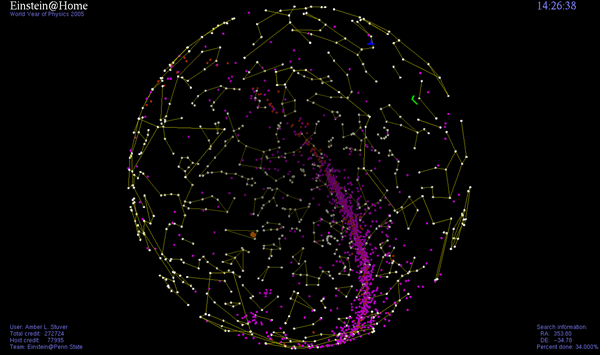Key Takeaways:
Binary pulsars—systems of two dead stars, at least one of which is a radiating pulsar—sit on a special pedestal in astronomy. The first discovery of such a system in 1974 also provided the first direct evidence of gravitational waves. And they continue to provide some of the best field laboratories for studying Einstein’s general relativity.
Patrick Lazarus from the Max Planck Institute for Radio Astronomy led a recent study published in the Astrophysical Journal investigating PSR J1913+1102. It’s the newest in a select group; only 14 pulsars are known to reside in binary neutron star pairs, making this latest addition a valuable lesson in both testing general relativity and learning more about how stars evolve. And it’s all the more interesting because some of the credit for the find goes to computers of average citizens.
Einstein@Home is one of a slew of science projects for idle home computers. Users sign up and download a simple program, and when they’re not working or scrolling through Facebook, the program quietly churns through data from any one of a number of projects, looking for gravitational waves. Or at least the signposts of a system that emits gravitational waves.
The original goal, according to Einstein@Home director Bruce Allen, was to harness the power of people’s computers to search data from the Laser Interferometer Gravitational-Wave Observatory (LIGO) for direct signals of gravitational waves. “But we analyzed the data from initial LIGO over a period of years and didn’t find anything.”
This is not the fault of Einstein@Home or its users. The observatory didn’t sense anything until the team upgraded it in 2015, when it immediately found signals from two black holes crashing together and made history. But that spectacular find was somewhat beside the point. Its Its true quarry was and remains continuous gravitational wave emission from spinning neutron stars, which give off quieter, continuous signals compared to the thunderous and short-lived crash of black holes.
During the long wait, Allen says, “I got really concerned… What’s going to keep [users] from saying this is a waste of time and getting discouraged?” But the problem that Einstein@Home was built to solve is broader than just searching LIGO data. LIGO represents what Allen calls a computationally limited dataset. Essentially, they have plenty of data. But it takes a lot of computer power to chug through and find anything useful in it.
But there are lots of problems like this for pulsars (and indeed, lots of other kinds of @Home projects even outside of astronomy). The Arecibo observatory scans the sky for radio pulsars. The Fermi satellite watches for them in gamma rays. So while Einstein@Home waited for LIGO to turn up signals, they began feeding users’ computers these other projects as well.
“Since around 2012, every gamma-ray pulsar that’s been found by gamma-ray emission has been found by Einstein@Home,” Allen says. Most gamma-ray pulsars are identified first by their radio waves, so this is a small subset of all gamma-ray pulsar. But it speaks to the value of Einstein@Home, which can find clues other projects just don’t have the computing power or time to drill down to. And the results all feed into the eventual goal: finding continuous gravitational waves from binary pulsars.
The latest result, PSR J1913+1102, is a radio pulsar Einstein@Home computers found in data from Arecibo. Because its partner is silent, at first astronomers only knew that the system contained a pulsar plus a companion in orbit. They pieced together numerous lines of evidence to arrive at the full picture. First, the total mass of the system was large, meaning the pulsar’s companion was at least as massive as the Sun. Many pulsars orbit smaller white dwarfs, so this was a big tip. Second, the nearly—but not quite—circular orbit of the system suggests that some force kicked the system after the pulsar had already evolved. The most reasonable explanation, then, is that the companion is also a neutron star, and the kick was its own supernova explosion as it ended its life as a main sequence star.
The stars orbit each other just under every five hours, and will take roughly half a billion years to merge together. This takes them out of the category of short-period binaries—which orbit every few minutes—that gravitational wave hunters truly hunger for. The system will still allow for some measurements of general relativity, however.
But the unevenly matched masses of the two neutron stars will allow astronomers to explore something completely new: the more massive star tidally ripping apart its companion. Researchers theorize that such extreme events are responsible for creating the heavy elements in the universe, but so far no real-world example has been accessible. If researchers can confirm the masses of the partners, PSR J1913+1102 would be the first of its kind.










